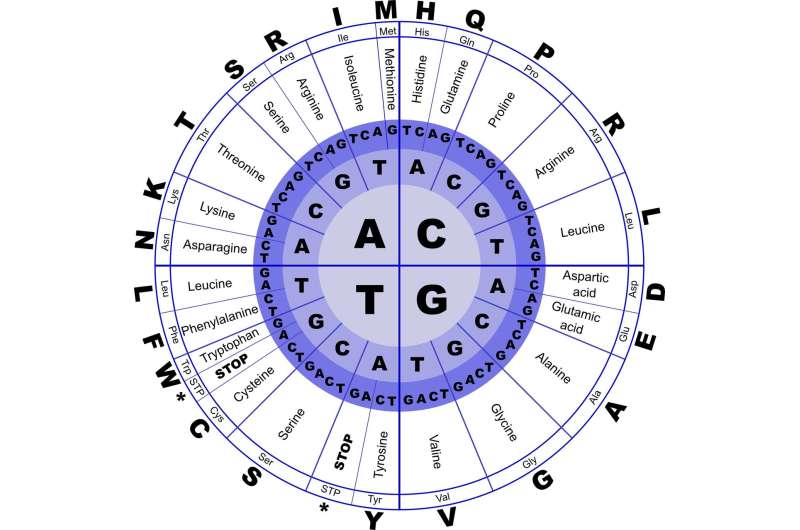
In a study published in the journal Nature, researchers from the Center for Genomic Regulation (CRG) and the Wellcome Sanger Institute have discovered that mutations affect protein stability following remarkably simple rules. The discovery has profound implications for accelerating the development of new treatments for diseases or the design of new proteins with industrial applications.
Proteins are chains made up of twenty different types of smaller units called amino acids. A single mutation swaps one amino acid for another, changing the protein’s shape. This can mark the difference between health and disease. Many diseases, including cancer and neurodegenerative disorders, are caused by more than one mutation in a protein.
Predicting how mutations alter a protein’s shape is critical for understanding their contribution to disease. However, with so many amino acids in a protein, there are an astronomical number of ways mutations can combine. Experimentally testing each possible combination to see how they affect a protein is practically impossible.
“There are 17 billion different combinations of a protein that is 34 amino acids in length with only a single change allowed at each position. If it took just one second to test a single combination, we’d need a total of 539 years to try them all. It’s not a feasible experiment,” says Aina Martí Aranda, co-author of the study who began the project at the CRG and is currently a Ph.D. student at the Wellcome Sanger Institute in the UK.
As proteins get longer, the different number of combinations rises exponentially. For a protein one hundred amino acids long, there are more possible combinations than there are atoms in the entire universe. The vast majority of known proteins, especially those contributing to human disease, are much longer.
Even in this vast landscape of possibilities, research led by Dr. André Faure at the Center for Genomic Regulation in Barcelona and ICREA Research Professor Ben Lehner, with dual affiliation between the CRG and the Wellcome Sanger Institute, have discovered that the impact of mutations on protein stability is more predictable than previously thought.
For years, there has been an underlying assumption that two mutations might interact with each other in unexpected ways, enhancing or suppressing each other’s effects. “The fear that two mutations interacting can unpredictably affect the whole structure made us use incredibly complex models,” says Martí Aranda.
The study found that while mutations do interact, it is a relatively rare occurrence, and the vast majority affect a protein independently of each other.
“Our discovery turns an old understanding on its head, showing that the endless possibilities of protein mutations boil down to straightforward rules. We don’t need supercomputers to predict a protein’s behavior—just good measurements and simple math will do,” says Dr. Lehner.
The researchers made the discovery by generating thousands of protein variants, each with different combinations of mutations that could produce functional proteins. They then tested the stability of the proteins, generating a vast amount of data on how each mutation and combination of mutations affect proteins.
The experimental outcomes closely matched models which assume that the total effect of multiple mutations can be calculated by simply adding up the effects of each individual mutation.
The findings can help better understand and target genetic diseases. For example, some genetic disorders are caused by many mutations in one protein. Patients may have different combinations of mutations, making it challenging to predict disease severity and response to treatments.
With the new understanding that most mutations act independently, clinicians can find new ways of predicting how various mutation combinations affect a protein’s stability and function. This can lead to more accurate prognoses and personalized treatment plans, improving patient outcomes.
The study can also lead to more efficient drug development. Some drugs correct misfolded proteins, such as in Alzheimer’s disease, where the changing shape of amyloid-beta proteins form plaques in the brain. Researchers can now better predict which mutations are most destabilizing and design molecules that specifically stabilize these regions.
The study also has implications for biotechnologists using protein design to tackle different types of problems. For example, some enzymes have the ability to break down plastics in the environment. Researchers could design new enzymes with enhanced activity and stability by adding beneficial mutations together.
While the discovery is a significant advance, the researchers raise some limitations in the study. For example, they did not capture more complex interactions involving three or more mutations. In some proteins, these higher-order interactions could significantly impact stability and are not predicted by simply adding up individual effects.
Also, while the findings can dramatically reduce the number of experiments needed, some level of experimental validation is still necessary to confirm predictions, especially for critical applications like drug development where there may be unforeseen effects or rare interactions that the models do not capture.
More information:
Ben Lehner, The genetic architecture of protein stability, Nature (2024). DOI: 10.1038/s41586-024-07966-0. www.nature.com/articles/s41586-024-07966-0
Provided by
Center for Genomic Regulation
Citation:
Mutations that affect protein stability follow simple math rules, study shows (2024, September 25)
retrieved 26 September 2024
from https://phys.org/news/2024-09-mutations-affect-protein-stability-simple.html
This document is subject to copyright. Apart from any fair dealing for the purpose of private study or research, no
part may be reproduced without the written permission. The content is provided for information purposes only.


